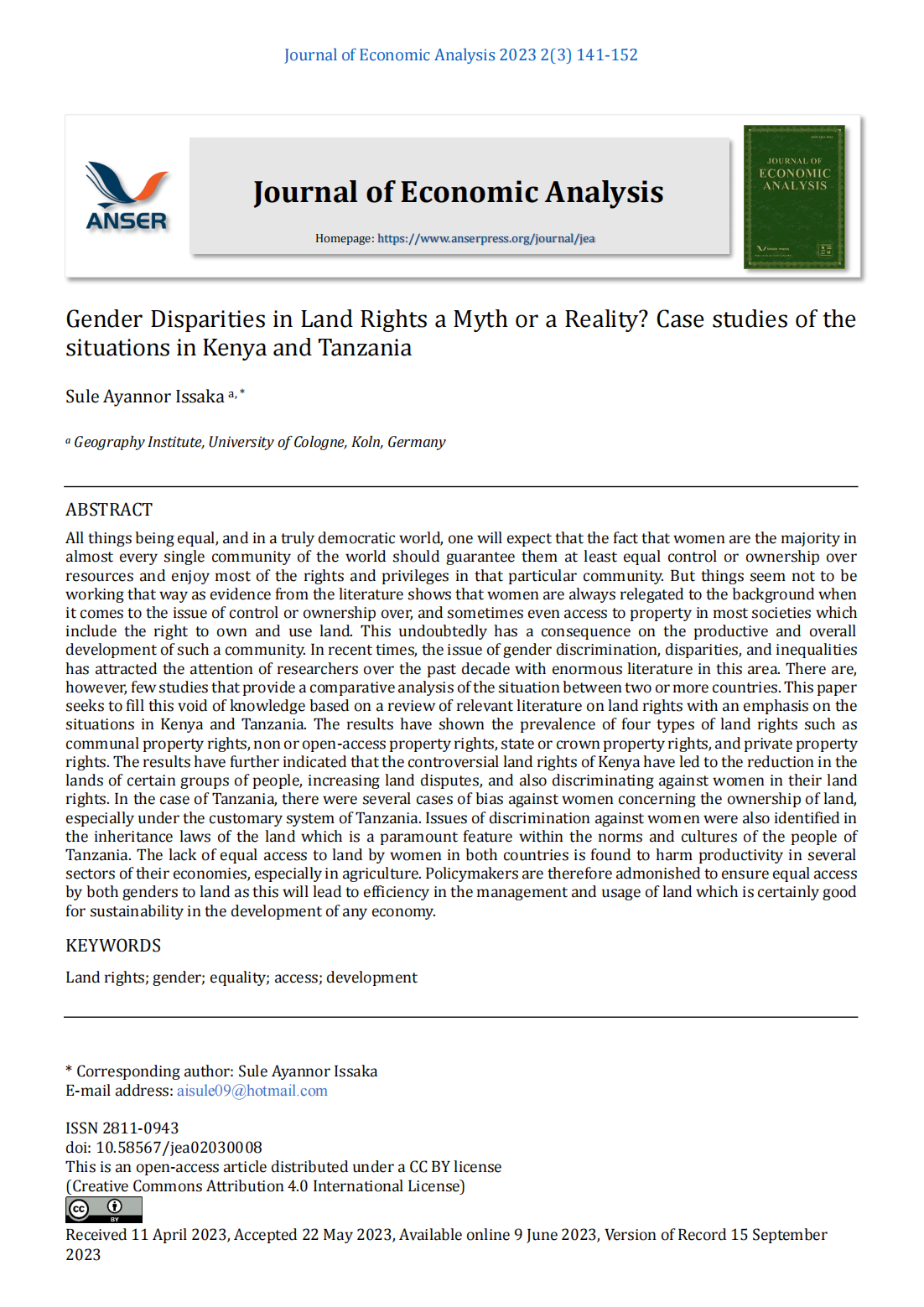Gender Disparities in Land Rights a Myth or a Reality? Case studies of the situations in Kenya and Tanzania
DOI:
https://doi.org/10.58567/jea02030008Keywords:
Land rights; gender; equality; access; developmentAbstract
All things being equal, and in a truly democratic world, one will expect that the fact that women are the majority in almost every single community of the world should guarantee them at least equal control or ownership over resources and enjoy most of the rights and privileges in that particular community. But things seem not to be working that way as evidence from the literature shows that women are always relegated to the background when it comes to the issue of control or ownership over, and sometimes even access to property in most societies which include the right to own and use land. This undoubtedly has a consequence on the productive and overall development of such a community. In recent times, the issue of gender discrimination, disparities, and inequalities has attracted the attention of researchers over the past decade with enormous literature in this area. There are, however, few studies that provide a comparative analysis of the situation between two or more countries. This paper seeks to fill this void of knowledge based on a review of relevant literature on land rights with an emphasis on the situations in Kenya and Tanzania. The results have shown the prevalence of four types of land rights such as communal property rights, non or open-access property rights, state or crown property rights, and private property rights. The results have further indicated that the controversial land rights of Kenya have led to the reduction in the lands of certain groups of people, increasing land disputes, and also discriminating against women in their land rights. In the case of Tanzania, there were several cases of bias against women concerning the ownership of land, especially under the customary system of Tanzania...
References
Agarwal, B. (1994). Gender and command over property: A critical gap in economic analysis and policy in South Asia. World Development, 22(10), 1455–1478. https://doi.org/10.1016/0305-750X(94)90031-0
Aliber, M., and Walker, C. (2006). The impact of HIV/AIDS on land rights: Perspectives from Kenya. World Development, 34(4), 704–727. https://doi.org/10.1016/j.worlddev.2005.09.010
Alston, P. (2005). Ships passing in the night: the current state of the human rights and development debate seen through the lens of the Millennium Development Goals. Hum. Rts. Q., 27, 755. https://heinonline.org/HOL/P?h=hein.journals/hurq27&i=763
Baumeister, R. F., and Leary, M. R. (1997). Writing Narrative Literature Reviews. Review of General Psychology, 1(3), 311–320. https://doi.org/10.1037/1089-2680.1.3.311.
Benschop, M. (2002). Rights and reality: are women’s equal rights to land, housing, and property implemented in East Africa? Un-Habitat. https://books.google.de/books?id=4o1qUAVJyrQC&lpg
Binswanger, H. P., and Deininger, K. (1993). South African land policy: The legacy of history and current options. World Development.21 (9),1451–1475. https://scholar.google.com/scholar?hl=en&as_sdt=0%2C5&q=Binswanger
Coombe, R. J. (1998). Intellectual Property, Human Rights and (and) Sovereignty: New Dilemmas in International Law Posed by Recognition of Indigenous Knowledge and the Conservation of Biodiversity. Ind. J. Global Legal Stud., 6, 59. https://heinonline.org/HOL/P?h=hein.journals/ijgls6&i=65
Deere, C. D., and Leon, M. (2003). The gender asset gap: Land in Latin America. World Development, 31(6), 925–947. https://doi.org/10.1016/S0305-750X(03)00046-9
Feder, G., and Feeny, D. (1991). (1991). Land tenure and property rights: Theory and implications for development policy. The World Bank Economic Review, 5(1), 135-153.
Ikdahl, I., Hellum, A., Kaarhhus, R., Benjaminsen, T. A., & Kameri-Mbote, P. (2005). Human rights, formalization, and women's land rights in Southern and Eastern Africa. University of Nairobi. http://erepository.uonbi.ac.ke/bitstream/handle/11295/55127/Human%20rights
Kameri-Mbote, P. (2006). Women, land rights and the environment: The Kenyan experience. Development, 49(3), 43–48. https://doi.org/10.1057/palgrave.development.1100274
Kariyasa, K., and Dewi, Y. A. (2011). This document is discoverable and free to researchers across the globe due to the work of AgEcon Search. Help ensure our sustainability. Journal of Gender, Agriculture and Food Security, 1(3), 1–22. file:///C:/Users/admin/Downloads/Hoag.pdf
Khasiani, S. (1992). Groundwork: African women as environmental managers. http://hdl.handle.net/11295/38621
KNBS. (2019). 2019 Kenya Population and Housing Census Results.
Leavens and Anderson. (2011). Gender and Agriculture in Tanzania Gender issues in land policy and administration. 134, 14. https://evans.uw.edu/sites/default/files/public/UW_EPAR_Request_134_Gender and Ag_04102011.pdf
Libecap, G. D. (1993). Contracting for property rights. Cambridge University Press.
Magambo, E. F., and Nyamwesa, A. M. (2022). Gender Gap in Asset Ownership: Tanzania State of Play. African Journal of Applied Research, 8(1), 351–361. https://doi.org/10.26437/ajar.03.2022.23
Mallya, E. (2005). Women NGOs and the Policy Process in Tanzania : The Case of the Land Act of 1999. African Study Monographs, 26(4), 183–200. https://citeseerx.ist.psu.edu/document?repid=rep1&type=pdf&doi=a546226bda4c8b279484ba1320dfcdf6dec1aaea
Merry, S. E. (2006). Transnational human rights and local activism: Mapping the middle. American Anthropologist, 108(1), 38-51. https://doi.org/10.1525/aa.2006.108.1.38
NBS. (2022). 2022 Tanzania in figures. https://so04.tci-thaijo.org/index.php/colakkujournals/article/view/255274
North, D. C., and Thomas, R. P. (1973). The rise of the Western world: A new economic history. Cambridge University Press. https://books.google.de/books?id=MEh_54l-dK8C&lpg=PP9&ots=d4fRzpawSQ&dq
Peterman, A. (2007). Women s property rights and gendered policies : Implications for women’s s long - term welfare in rural Tanzania Research Questions. https://doi.org/10.1111/j.1467-7679.2012.00588.x
Rao, N. (2006). Land rights, gender equality, and household food security: Exploring the conceptual links in the case of India. Food Policy, 31(2), 180–193. https://doi.org/10.1016/j.foodpol.2005.10.006
Rocheleau. (1995). Gender, Environment, and Development in Kenya. Lynne Rienner Publishers. https://doi.org/10.1515/9781685856007
Snyder, H. (2019). Literature review as a research methodology: An overview and guidelines. Journal of Business Research, 104(March), 333–339. https://doi.org/10.1016/j.jbusres.2019.07.039
Sorrenson, M. P. K. (1967). Land reform in the Kikuyu country. Land reform in the Kikuyu country. https://www.cabdirect.org/cabdirect/abstract/19681800083
Swinnen, J. F. (1999). The political economy of land reform choices in Central and Eastern Europe. Economics of transition. 7(3), 637-664. https://doi.org/10.1111/1468-0351.00029
Tripp, A. M. (2004). Women’s movements, customary law, and land rights in Africa: The case of Uganda. African Studies Quarterly, 7(4), 1–19. https://asq.africa.ufl.edu/wp-content/uploads/sites/168/v7i4.pdf

Downloads
Published
How to Cite
Issue
Section
License
Copyright (c) 2023 Sule Ayannor Issaka

This work is licensed under a Creative Commons Attribution 4.0 International License.



